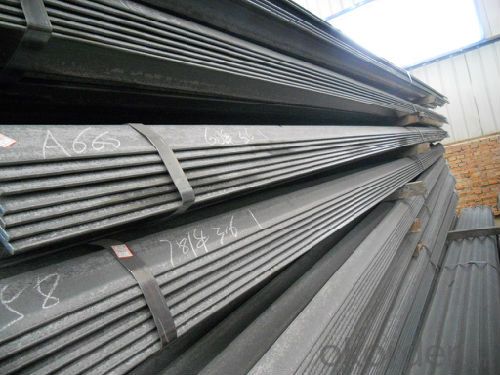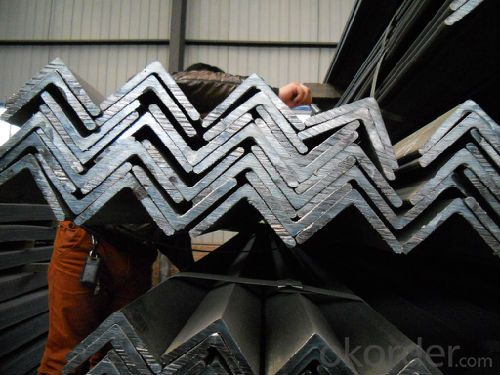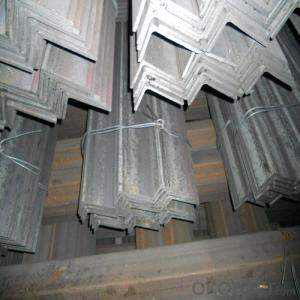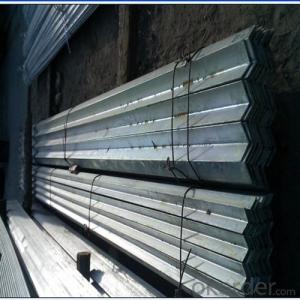Hot Rolled Steel Angle Euqal Angle Bar Uneuqal Angle Bar Q235
- Loading Port:
- Tianjin
- Payment Terms:
- TT or LC
- Min Order Qty:
- 50 m.t.
- Supply Capability:
- 50000 m.t./month
OKorder Service Pledge
OKorder Financial Service
You Might Also Like
Product Description:
OKorder is offering high quality Hot Rolled Steel I-Beams at great prices with worldwide shipping. Our supplier is a world-class manufacturer of steel, with our products utilized the world over. OKorder annually supplies products to European, North American and Asian markets. We provide quotations within 24 hours of receiving an inquiry and guarantee competitive prices.
Product Applications:
Hot Rolled Steel I-Beams are ideal for structural applications and are widely used in the construction of buildings and bridges, and the manufacturing, petrochemical, and transportation industries.
Product Advantages:
OKorder's Steel I-Beams are durable, strong, and resist corrosion.
Main Product Features:
· Premium quality
· Prompt delivery & seaworthy packing (30 days after receiving deposit)
· Corrosion resistance
· Can be recycled and reused
· Mill test certification
· Professional Service
· Competitive pricing
Product Specifications:
1.Grade: SS200,300,400 series
2.Size: 25×25×3 mm-100×100×10mm
3.Process: HRAP
4. Length: 2-6m
5. Shape: Equal
6. Delivery: within 20 days
7. MOQ: 1 ton
8. Certificate: ISO 9001:2008, SGS
9. Package:Standard Export Packing, or put into wooden boxes according to your requirement
10. Application: Construction, Marine, Industry and so on
Name | Stainless Steel Angles | ||||||
Standard | ASTM A554, A312, A249, A269 and A270 | ||||||
Material Grade | 304,316,201,202, 316L,430 | ||||||
Length | 6m or as customers' request | ||||||
Tolerance | a) thickness: +/-0. 15mm | ||||||
b) Length:+/-4. 5mm - 0mm | |||||||
Surface | 180G, 320G, 400G Satin / Hairline(Matt Finish, Brush, Dull Finish) 400G, 500G, 600G or 800G Mirror finish | ||||||
Application | Decoration construction, upholstery, industry instruments | ||||||
Test | Squash test, Extended test, Water pressure test, Crystal rot test, Heat treatment, NDT | ||||||
Chemical Composition of Material |
Composition
Material | 201 | 202 | 304 | 316L | 430 | |
C | ≤0.15 | ≤0.15 | ≤0.08 | ≤0.08 | ≤0.12 | ||
Si | ≤1.00 | ≤1.00 | ≤1.00 | ≤1.00 | ≤1.00 | ||
Mn | 5.5-7.5 | 7.5-10 | ≤2.00 | ≤2.00 | ≤1.00 | ||
P | ≤0.06 | ≤0.06 | ≤0.045 | ≤0.045 | ≤0.040 | ||
S | ≤0.03 | ≤0.03 | ≤0.030 | ≤0.030 | ≤0.030 | ||
Cr | 16-18 | 17-19 | 18-20 | 16-18 | 16-18 | ||
Ni | 3.5-5.5 | 4-6 | 8-10.5 | 10-14 | |||
Mo | 2.0-3.0 | ||||||
Mechanical Property | Material Item | 201 | 202 | 304 | 316L | ||
Tensile Strength | ≥535 | ≥520 | ≥520 | ≥520 | |||
Yield Strength | ≥245 | ≥205 | ≥205 | ≥205 | |||
Extension | ≥30% | ≥30% | ≥35% | ≥35% | |||
Hardness (HV) | <253 | <253 | <200 | <200 | |||
FAQ:
Q1: Why buy Materials & Equipment from OKorder.com?
A1: All products offered byOKorder.com are carefully selected from China's most reliable manufacturing enterprises. Through its ISO certifications, OKorder.com adheres to the highest standards and a commitment to supply chain safety and customer satisfaction.
Q2: How do we guarantee the quality of our products?
A2: We have established an advanced quality management system which conducts strict quality tests at every step, from raw materials to the final product. At the same time, we provide extensive follow-up service assurances as required.
Q3: How soon can we receive the product after purchase?
A3: Within three days of placing an order, we will begin production. The specific shipping date is dependent upon international and government factors, but is typically 7 to 10 workdays.
Q4: What makes stainless steel stainless?
A4: Stainless steel must contain at least 10.5 % chromium. It is this element that reacts with the oxygen in the air to form a complex chrome-oxide surface layer that is invisible but strong enough to prevent further oxygen from "staining" (rusting) the surface. Higher levels of chromium and the addition of other alloying elements such as nickel and molybdenum enhance this surface layer and improve the corrosion resistance of the stainless material.
Q5: Can stainless steel rust?
A5: Stainless does not "rust" as you think of regular steel rusting with a red oxide on the surface that flakes off. If you see red rust it is probably due to some iron particles that have contaminated the surface of the stainless steel and it is these iron particles that are rusting. Look at the source of the rusting and see if you can remove it from the surface.
Images:



- Q:What are the common installation methods for steel angles?
- Different installation methods exist for steel angles, depending on the application and desired outcome. Several options are commonly employed: 1. Welding stands as a favored technique, melding the base metal with the steel angle to create a sturdy and enduring connection. It finds extensive use in structural applications that necessitate strength and stability. 2. Bolting represents another popular method, involving the attachment of the steel angle to the desired surface through the use of bolts, nuts, and washers. This approach allows for convenient disassembly and reassembly, making it ideal for situations requiring frequent adjustments or modifications. 3. Adhesive bonding can be employed in certain cases, utilizing a high-strength adhesive to bond the angle to the surface. Typically, adhesive bonding is chosen when welding or bolting is impractical or undesirable. 4. Mechanical fasteners, such as screws, nails, or rivets, offer an additional means of installing steel angles. This method is commonly utilized in non-structural applications or when a temporary installation is required. In selecting an installation method for steel angles, it is crucial to consider factors such as load-bearing capacity, environmental conditions, and project-specific requirements. Consulting with a structural engineer or a professional experienced in steel fabrication and installation is advisable to ensure a proper and secure installation.
- Q:How do steel angles contribute to the overall stiffness of a structure?
- Steel angles contribute to the overall stiffness of a structure by providing stability and resistance to bending or twisting forces. These angles are commonly used in construction to reinforce joints, corners, and connections, effectively distributing loads and enhancing the structural integrity. Their shape and rigidity help prevent deflection and ensure that the structure remains stable and capable of withstanding external pressures or movements.
- Q:Are steel angles suitable for agricultural applications?
- Yes, steel angles are suitable for agricultural applications. Steel angles are versatile and durable, making them ideal for various agricultural purposes. They can be used for constructing sturdy frames for greenhouses, barns, and storage buildings. Steel angles provide excellent structural support and can withstand heavy loads, making them suitable for building sturdy fences, gates, and livestock enclosures. Additionally, steel angles are resistant to corrosion, which is crucial in agricultural environments where exposure to moisture and chemicals is common. The versatility and durability of steel angles make them a reliable choice for agricultural applications.
- Q:How do you prevent steel angles from vibrating?
- To prevent steel angles from vibrating, there are several approaches that can be taken: 1. Damping materials are effective in absorbing and dissipating vibrations. Rubber pads, neoprene, or foam can be placed between the steel angles and the structure they are attached to. 2. Structural modifications can help reduce vibrations. Additional supports or bracing can be added to reinforce the steel angles, increasing the stiffness and rigidity of the structure. 3. Adding extra mass to the steel angles can stabilize them and minimize vibrations. This can be achieved by attaching weight plates or heavier components. 4. Tensioning the steel angles can reduce vibrations by increasing their natural frequency and stiffness. Bolts can be tightened or tensioning devices can be used. 5. Vibration isolation techniques can effectively minimize vibration transmission. Mounting the steel angles on rubber isolators or spring mounts isolates them from the surrounding structure. 6. Resonance avoidance is crucial in preventing vibrations. By analyzing the structural dynamics and adjusting the design or operating conditions, the natural frequencies of the steel angles can be identified and avoided. 7. Regular maintenance is important to identify any potential sources of vibrations. Checking for loose connections, corrosion, or signs of wear and tear can help prevent vibration problems. It is important to consider various factors such as the application, structural design, and environmental conditions when choosing the best method(s) to prevent steel angles from vibrating. Consulting with a structural engineer or vibration specialist is recommended to ensure the most suitable and effective solution is implemented.
- Q:What are the different methods of surface galvanizing for steel angles?
- There are several different methods of surface galvanizing for steel angles, each with its own unique advantages and applications. Here are some of the most common methods: 1. Hot-dip galvanizing: This is the most widely used method of galvanizing steel angles. It involves immersing the steel angles in a bath of molten zinc, which forms a metallurgical bond with the surface of the steel. This process provides excellent corrosion protection and durability, making it suitable for a wide range of applications. 2. Electro-galvanizing: In this method, a thin layer of zinc is electrodeposited onto the surface of the steel angles. It is a more controlled process compared to hot-dip galvanizing and offers a smoother and more uniform coating. Electro-galvanizing is often used for decorative purposes or in applications where a thinner coating is sufficient. 3. Sherardizing: This method involves coating the steel angles with a mixture of zinc dust and a proprietary filler material, such as aluminum or iron powder. The coated angles are then heated in a furnace, causing the zinc to diffuse into the surface of the steel and form a durable alloy layer. Sherardizing provides excellent corrosion protection and is commonly used in applications where high resistance to wear and abrasion is required. 4. Mechanical galvanizing: Also known as centrifuge galvanizing, this method involves tumbling the steel angles in a drum or barrel with zinc powder and glass beads. The tumbling action causes the zinc powder to adhere to the surface of the steel angles, creating a protective coating. Mechanical galvanizing is often used for small or intricate parts that are difficult to galvanize by other methods. 5. Zinc-rich paint: Although not a traditional galvanizing method, zinc-rich paint can provide a similar level of corrosion protection. It involves applying a paint or coating that contains a high concentration of zinc particles to the surface of the steel angles. The zinc particles act as sacrificial anodes, corroding in place of the steel and providing protection against rust and corrosion. These are just a few of the different methods of surface galvanizing for steel angles. The choice of method depends on factors such as the desired level of corrosion protection, the specific application requirements, and cost considerations. It is important to consult with a galvanizing professional to determine the most suitable method for your specific needs.
- Q:Can steel angles be used in pedestrian bridges?
- Pedestrian bridges can indeed make use of steel angles in their construction. The high strength-to-weight ratio and versatility of steel angles make them a common choice in bridge construction. These angles are frequently employed as structural elements, providing the necessary support, stability, and rigidity to the bridge structure. With their ability to withstand heavy loads and forces, steel angles are well-suited for pedestrian bridges, which must bear the weight of individuals walking across. Moreover, steel angles can be easily fabricated and welded, enabling flexibility in the design and construction of pedestrian bridges. All in all, steel angles are widely favored for constructing pedestrian bridges due to their durability, strength, and user-friendly nature.
- Q:Can steel angles be customized or fabricated to specific requirements?
- Yes, steel angles can be customized or fabricated to specific requirements.
- Q:Can steel angles be used for agricultural buildings or barns?
- Indeed, agricultural buildings or barns can employ steel angles. The prevailing usage of steel angles in construction is attributed to their robustness and endurance. Specifically, they prove invaluable in agricultural buildings or barns, where the structure must endure substantial burdens and adverse weather conditions. Steel angles can be employed in the framing, bracing, and reinforcement of diverse building constituents, including walls, roofs, and doors. Furthermore, steel angles can be readily fabricated and tailored to fulfill precise design specifications, rendering them a multifaceted option for agricultural buildings or barns.
- Q:What is the minimum length of a steel angle?
- The minimum length of a steel angle can vary depending on the specific requirements and applications. Steel angles are typically available in standard lengths ranging from 20 feet to 40 feet. However, it is possible to cut steel angles to shorter lengths if needed. The minimum length of a steel angle would ultimately depend on factors such as the project specifications, structural requirements, and the supplier's capabilities. It is recommended to consult with a steel supplier or a structural engineer to determine the minimum length needed for a specific application.
- Q:What is the carbon content of steel angles?
- The carbon content of steel angles may differ based on the particular grade and type of steel employed. Typically, carbon steel angles possess a carbon content that spans from 0.05% to 0.25%. Nevertheless, certain high carbon steel angles can exhibit a carbon content reaching up to 2.1%. The carbon content of steel angles holds significant importance, as it impacts the strength, hardness, and overall characteristics of the steel.
1. Manufacturer Overview |
|
|---|---|
| Location | |
| Year Established | |
| Annual Output Value | |
| Main Markets | |
| Company Certifications | |
2. Manufacturer Certificates |
|
|---|---|
| a) Certification Name | |
| Range | |
| Reference | |
| Validity Period | |
3. Manufacturer Capability |
|
|---|---|
| a)Trade Capacity | |
| Nearest Port | |
| Export Percentage | |
| No.of Employees in Trade Department | |
| Language Spoken: | |
| b)Factory Information | |
| Factory Size: | |
| No. of Production Lines | |
| Contract Manufacturing | |
| Product Price Range | |
Send your message to us
Hot Rolled Steel Angle Euqal Angle Bar Uneuqal Angle Bar Q235
- Loading Port:
- Tianjin
- Payment Terms:
- TT or LC
- Min Order Qty:
- 50 m.t.
- Supply Capability:
- 50000 m.t./month
OKorder Service Pledge
OKorder Financial Service
Similar products
New products
Hot products
Related keywords



























